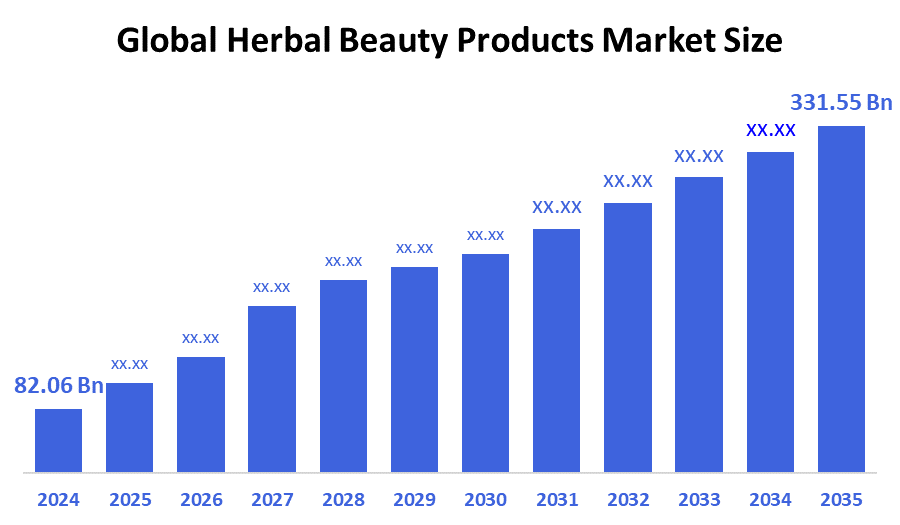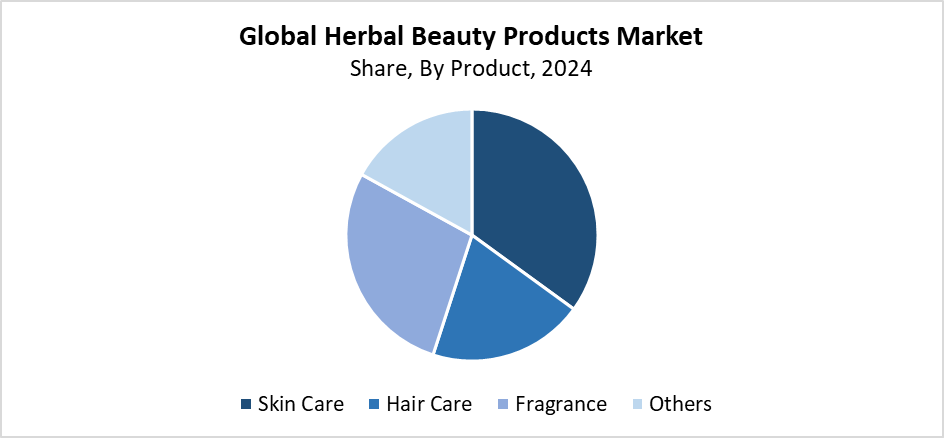Global Herbal Beauty Products Market
Global Herbal Beauty Products Market Size, Share, and COVID-19 Impact Analysis, By Product (Skin Care, Hair Care, Fragrance, Others), By End-use (Men, Women), and By Region (North America, Europe, Asia-Pacific, Latin America, Middle East, and Africa), Analysis and Forecast 2025-2035
Report Overview
Table of Contents
Herbal Beauty Products Market Summary
The Global Herbal Beauty Products Market Size Was Estimated at USD 82.06 Billion in 2024 and is Projected to Reach USD 331.55 Billion by 2035, Growing at a CAGR of 13.53% from 2025 to 2035. The market for herbal beauty products is expanding as a result of growing consumer awareness of natural ingredients, growing demand for skincare products free of chemicals, eco-friendly trends, the preference for traditional remedies in certain cultures, and aggressive marketing by herbal and organic beauty brands.

Key Regional and Segment-Wise Insights
- With the biggest revenue share of 33.2% in 2024, the North American market for herbal beauty products led the global market.
- In 2024, the skincare segment had the biggest revenue share of 35.6% and led the market by product.
- In 2024, the women segment held the biggest revenue share and dominated the market by end use.
Global Market Forecast and Revenue Outlook
- 2024 Market Size: USD 82.06 Billion
- 2035 Projected Market Size: USD 331.55 Billion
- CAGR (2025-2035): 13.53%
- North America: Largest market in 2024
The market for herbal beauty products includes natural skincare, along with hair care and cosmetics, which exclude synthetic chemicals and harmful additives yet contain plant-based ingredients. These products attract customers who want better alternatives to conventional beauty products because they are more environmentally friendly and less harmful. The market growth is driven by three main factors: rising consumer interest in organic and cruelty-free products, increasing knowledge of synthetic chemical side effects, and the demand for eco-friendly, sustainable beauty products. The popularity of herbal beauty products worldwide surged because of rising health and wellness trends, along with social media exposure and endorsements from celebrities.
Technological advancements have substantially enhanced the effectiveness together with safety standards of herbal beauty products. Advanced extraction methods, such as cold pressing and supercritical fluid extraction, enable higher potency and purity of active substances. The natural benefits of these products remain intact while modern formulation techniques enhance their stability and texture and lengthen their shelf life. Various governments across the world promote the herbal and natural product industries through quality standards, along with research funding and supportive policies that protect consumers. The availability of premium raw materials is also ensured by initiatives supporting organic farming and sustainable procurement, which promotes market expansion and customer confidence.
Product Insights

In 2024, the skincare segment dominated herbal beauty products with the largest revenue share of 35.6%. The market domination results from expanding consumer awareness of natural substance benefits for aging and sensitive skin. The recommendation for herbal skincare products, which include face creams, serums, cleansers, and masks, stems from their chemical-free nature and their gentle yet effective properties. The market growth receives additional support from the increasing consumer interest in botanical extract-based moisturizing, anti-aging, and acne-treatment products. Millennials, together with Gen Z customers, show a strong preference for skincare products that are organic and cruelty-free. The segment maintains its strong global position through continuous innovation and extensive availability of herbal skincare products across retail stores and online platforms.
During the projected timeframe, the herbal beauty products market's fragrance segment is expected to grow at the fastest CAGR. Modern consumers who understand synthetic fragrance harm now prefer to purchase natural and chemical-free perfumes and deodorants, which leads to rapid market expansion. Herbal perfumes use essential oils and botanical extracts to make skin-friendly, fragrant products. The herbal fragrance product sector grows because more people seek personalized and handcrafted scents. The market expansion of specialty stores, along with online sales and developments in long-lasting, eco-friendly formulas, has led to increased availability of these products, which now attract more consumers. The combination of various market factors will drive significant growth in the fragrance market over the next years.
End-use Insights
The women's category dominated the herbal beauty products market in 2024, accounting for the largest revenue share. Women drive this market leadership because they seek natural beauty products that handle hormonal changes along with signs of aging and skin sensitivity issues. Women choose herbal skincare, haircare, and cosmetic products because they believe these products offer health advantages and lack the harmful effects that synthetic products possess. The combination of social media impact and the expanding wellness movement has driven rising demand from female customers, specifically those from millennial and Gen Z demographics. The market growth has been supported by the availability of herbal medicines, which target specific cosmetic problems such as acne, hydration needs, and anti-aging solutions. The market continues to expand since women have substantial buying power, and they are becoming more aware.
During the forecast period, the herbal beauty products market men segment is anticipated to experience growth at the fastest CAGR. The rising awareness among men about personal grooming, along with natural chemical-free products for their skin, drives this growth trend. The increasing concern about skin sensitivity, together with acne and hair care issues, leads men to transition from standard products to herbal alternatives. The rising popularity of companies, together with marketing campaigns that focus on male consumers, has increased market demand. The transformation of public views about male grooming, along with self-care practices, stands as a crucial element in this scenario. The rapid expansion of e-commerce platforms and urbanization enables easy access to various herbal beauty products, which drives this sector to become one of the fastest-expanding segments.
Regional Insights
The herbal beauty products market in North America led worldwide with a 33.2% revenue share during 2024. The main reasons behind this leadership position stem from consumer awareness about natural ingredients, combined with increasing demand for green beauty products without chemicals. The region's strong purchasing power, together with its established beauty and personal care market, drives the widespread usage of herbal products throughout the area. Market growth continues because of recognized brands alongside new product development and strict regulations that guarantee both safety and product quality. The North American herbal beauty industry maintains its growth trajectory because of increasing consumer interest in sustainable products, along with wellness and cruelty-free options, and the expansion of both retail stores and online shopping platforms.
Europe Herbal Beauty Products Market Trends
The European herbal beauty products market held a significant market share during 2024 because consumers actively sought sustainable and natural beauty products. The increasing popularity of herbal and organic skincare, haircare, and cosmetic products throughout Europe stems from rising consumer awareness about synthetic chemical side effects. The region's rigorous quality standards, together with its regulatory frameworks, ensure both product effectiveness and safety, which builds stronger consumer trust. Market expansion results from consumers adopting eco-friendly lifestyles alongside increasing interest in vegan and cruelty-free product options. The advanced retail network in Europe supports the wide distribution of herbal beauty products through both dedicated stores and expanding online platforms. The region holds the top position in the global market because of its numerous popular herbal brands, together with continuous product innovations.
Asia Pacific Herbal Beauty Products Market Trends
The Asia Pacific herbal beauty products market is growing significantly throughout the forecast period because of rising urbanization and increasing consumer knowledge about natural and organic beauty products, as well as higher disposable incomes. The combination of traditional herbal remedy preferences with modern beauty trends drives strong demand for herbal skincare and haircare products and cosmetics in India, China, Japan, and Southeast Asian nations. The expanding middle class and rising health awareness lead people to choose herbal products instead of synthetic ones. Market accessibility improves through the rapid growth of e-commerce platforms alongside expanding selections of herbal products. The area experiences strong market growth because government initiatives support sustainable practices and organic farming methods.
Key Herbal Beauty Products Companies:
The following are the leading companies in the herbal beauty products market. These companies collectively hold the largest market share and dictate industry trends.
- Weleda
- MAV Beauty Brand
- Himalaya Wellness Company
- ARBONNE INTERNATIONAL, LLC
- Shahnaz
- Lotus Herbals
- Vasa Global Cosmetics
- Klienz Herbal
- Bio Veda Action Research Co.
- Hemas Holdings PLC.
- Others
Recent Developments
- In September 2024, along with more than 24 whole herbs, Indus Valley Organic introduced its first ready-to-apply herbal hair care pastes that included traditional constituents, including amla, bhringraj, shikakai, and brahmi.
- In June 2024, with an emphasis on sustainability and wellness, My Green Space entered the B2C market with a new line of herbal cosmetics. The all-natural products, which address the skin, hair, and face care needs of women, are devoid of chemicals, parabens, sulfates, and cruelty.
Market Segment
This study forecasts revenue at global, regional, and country levels from 2020 to 2035. Decision Advisors has segmented the herbal beauty products market based on the below-mentioned segments:
Global Herbal Beauty Products Market, By Product
- Skin Care
- Hair Care
- Fragrance
- Others
Global Herbal Beauty Products Market, By End Use
- Men
- Women
Global Herbal Beauty Products Market, By Regional Analysis
- North America
- US
- Canada
- Mexico
- Europe
- Germany
- UK
- France
- Italy
- Spain
- Russia
- Rest of Europe
- Asia Pacific
- China
- Japan
- India
- South Korea
- Australia
- Rest of Asia Pacific
- South America
- Brazil
- Argentina
- Rest of South America
- Middle East & Africa
- UAE
- Saudi Arabia
- Qatar
- South Africa
- Rest of the Middle East & Africa
Check Licence
Choose the plan that fits you best: Single User, Multi-User, or Enterprise solutions tailored for your needs.
We Have You Covered
- 24/7 Analyst Support
- Clients Across the Globe
- Tailored Insights
- Technology Tracking
- Competitive Intelligence
- Custom Research
- Syndicated Market Studies
- Market Overview
- Market Segmentation
- Growth Drivers
- Market Opportunities
- Regulatory Insights
- Innovation & Sustainability
Report Details
| Pages | 240 |
| Delivery | PDF & Excel via Email |
| Language | English |
| Release | Oct 2025 |
| Access | Download from this page |
